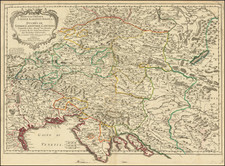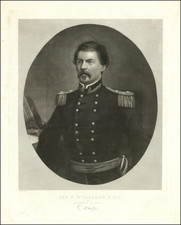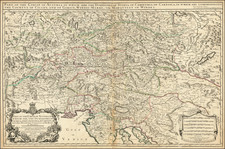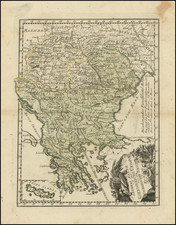This dignified and stately portrait presents Emperor Carl VI, the Holy Roman Emperor, seated in full regalia on his richly adorned throne.
The emperor is dressed in his royal attire of rich velvets and brocades, creating an aura of opulence. His left hand delicately rests on a golden orb, symbolizing his dominion over the earth and a universal Christian symbol of authority.
The throne upon which he sits is imposing, an apt representation of his imperial might. At the top corners of the throne, a pair of majestic eagles are perched, their wings slightly unfurled as though ready for flight. The eagles are a traditional symbol of the Holy Roman Empire, signifying strength, courage, and immortality.
At the emperor's feet, a cherub can be seen, holding a coat of arms with both hands. The inclusion of the cherub not only adds a divine element to the portrait but also serves as a reminder of the divine right of kings, underlining Carl's rule as sanctioned by God.
Romischer Kayser Carl VI (1685-1740) was the Holy Roman Emperor from 1711 until his death. Born in Vienna, he was the eldest son of Leopold I, and he succeeded his elder brother, Joseph I. Known for the Pragmatic Sanction of 1713 - an edict that ensured his daughter Maria Theresa would succeed him - Carl VI's reign was largely overshadowed by the turbulence that surrounded his succession and the subsequent War of Austrian Succession.
A capable monarch, Carl VI had a passion for the arts and music. His court was a center for the development of baroque music and art, attracting many of the leading artists and composers of the time, making his reign culturally vibrant. Despite his efforts to secure a smooth succession for his daughter, Carl VI's death led to the War of Austrian Succession, a conflict that reshaped the political map of Europe.
Alain Mannesson Mallet (1630-1706) was a French mapmaker and engineer who served in the armies of Louis XIV. After rising through the ranks, Mallet was appointed as Inspector of Fortifications, a job which also required mathematical skills and which made him a competent military engineer. Eventually, he joined the court of Louis XIV at Versailles, where he taught math and focused on writing.
Mallet is best known for his Description de L’Univers, first published in 1683, in five volumes. A wide-ranging geographical work, the Description included textual descriptions of the countries of the world, as well as maps of the celestial sky and the ancient and modern worlds. The Description continued to be published until the early eighteenth century. He also published a work in three volumes on warfare (1684) and a primer on geometry (1702).












![[ Tribal Germany ] Germania Antiqua in IV magnos populaos in minores et minimos distincta et Regiones Danubium…1785](https://storage.googleapis.com/raremaps/img/small/97958.jpg)

![(Cleveland Beer Drinkers) [Photograph of Zwiebel Brigade Drinking Beer in Cleveland]](https://storage.googleapis.com/raremaps/img/small/96294.jpg)